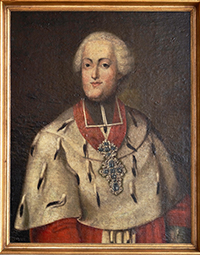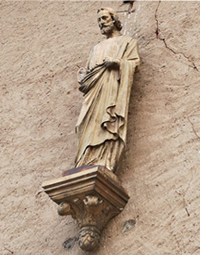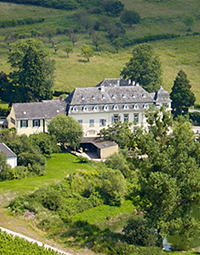History

Foundation of the Bischöfliches Priesterseminar
The vineyards of the Bischöfliches Priesterseminar (Episcopal Seminary) comprise 34 hectares of land, including sites such as Erdener Treppchen and Trittenheimer Apotheke on the Mosel, Kaseler Nies’chen on the Ruwer, and Ayler Kupp on the Saar.
In 1773, Archbishop-Elector Clemens Wenceslaus of Saxony founded the Bischöfliche Priesterseminar under the name “Seminarium Clementinum.” Till date, it is still the training center of the Roman Catholic Diocese of Trier for the priesthood.
Information about Clemens Wenzeslaus
 Clemens Wenzeslaus
Clemens WenzeslausThe 200th anniversary of Clemens Wenceslaus’s death was in July 2012. To be exact, he died on July 27th 1812, in Marktoberdorf in Allgäu. He was the Archbishop-Elector of Trier, Prince-Bishop of Augsburg, and Prince-Provostry of Ellwangen, among other titles. In addition, he was one of the most senior princes in the Holy Roman Empire.
Prince Clemens Wenceslaus of Saxony was open to the ideas of the Enlightenment. It comes as no surprise that as Elector of Trier he built up the school system even further in order to promote education and prosperity as well as to support the establishment of charitable institutions.
On October 30th 1787, he issued a regulation to improve the quality of the local wine industry.
Within seven years, as much Riesling as possible should be planted in the Mosel region. On the 200th anniversary of his death, the European Academy for Wine and Culture gave in the cellars of Bischöfliche Weingüter Trier a series of lectures and a Riesling back-vintage tasting, including wines dating back to 1937.
Foundation of the Bischöfliches Konvikt
The Bischöfliches Konvikt (Episcopal Seminary) includes 37 hectares of vineyards along all three rivers: Piesporter Goldtröpfchen and Avelsbacher on the Mosel, Ayler Kupp on the Saar, Eitelsbacher Marienholz and Kaseler Kehrnagel on the Ruwer. In Eitelsbach, Duisburger Hof, owned by the Bischöfliches Konvikt, is still used as the press house for all the grapes harvested in the Mosel and Ruwer.
In 1806, Bishop Karl Mannay set up in an outbuilding school, which he later called a “little seminary.” Since the original building was insufficient to meet the influx of students, they founded in the early 19th century a private charity that should reflect “on means and ways to study for the church, also for impecunious boys.” This allowed the seminary to take 16 boys on Easter 1840.
Information about Duisburger Hof

The rectagular farm complex, flanked with towers, is situated on a stunning slope, west of the Ruwer River, between the villages of Ruwer and Eitelsbach. The southern hall, built in the 14th century, is now a branch of the diocese archive.
The northern and eastern parts of the building are used as a press house for the cultivation of all the vineyards of the Bischöfliche Weingüter Trier along the Ruwer. Until the 16th century, the Duisburger Hof belonged to the Von Schönberg family.
An old coat of arms above the entrance states that Hugo Von Schönberg, canon of Trier, had the tower house modernized in 1571. In the 17th century, Archbishop Philipp Christoph Von Sötern acquired the farm complex.
His successor, Philipp Franz von Sötern, gave Duisburger Hof to the Cathedral of Trier, in the possession of which, remained until secularization by the French under Napoleon. After some years in private ownership, the Endres family sold Duisburger Hof to the Bischöfliches Konvikt in 1866.
With the merger of the vineyards of the Bischöfliches Konvikt with the Bischöfliches Priesterseminar and Hohe Domkirche, the northern and eastern part of Duisburger Hof was taken over by the Bischöfliche Weingüter Trier in 1966.


Foundation of Hohe Domkirche
Hohe Domkirche (Cathedral of Trier) owns 27 hectares of vines with 6 hectares in the precious Scharzhofberger in the Saar region. All the grapes that are harvested on the Saar are pressed in the legendary old Scharzhof in Wiltingen.
The history of the Cathedral of Trier – the oldest church in Germany and the oldest cathedral north of the Alps – goes back to the beginnings of Christianity. Emperor Constantine, who granted the persecuted Christians religious freedom in the fourth century, erected under Bishop Agritius in the years 310 to 320 the first great basilica in Trier. The building was considered the largest church of the Roman Empire.
The history of the cathedral has been closely associated with winegrowing. Documents dating back to 1249 show members of the Archdiocese were freed of their religious duties during the harvest.
Information about Scharzhof
 Scharzhof
Scharzhof
Scharzhofberg is one of the best vineyards in Germany. Since 1851, the Hohe Domkirche has owned the historical building on the Scharzhofstrasse. Few know that not only the wine but also the history of Scharzhof is legendary and goes back to the 10th century.
In 1030, Adalbero Von Luxembourg, provost of St. Paulin in Trier, bequeathed to the monastery of St. Maria ad martyres (today’s youth club ExHaus) a good five Hufen, or oxgang land. In 1239, ancient records mentioned for the first time a press house that belonged to the farm, which, however, was later torn down in 1905. In 1314, the monastery obtained four plots of vineyards that were probably in Scharzhofberg. The Benedictine Abbey of St. Marien built the Scharzhof of today in 1719. In 1801, during the French secularization, Johann Jakob Koch, a member of the Benedictine convent, bought the property by auction in Luxembourg. He purchased it on behalf of his abbot Placidus Mannebach. Koch, who was an active priest in the parish of Wiltingen, married his housekeeper and drove off his former religious brothers out of the estate, which he kept for himself.
The “Quereinhaus” and the other adjoining buildings were divided up after Koch’s death in 1829.
The old Scharzhof was then sold by Clara Koch, who wanted to atone for her father’s breach of celibacy, to the Hohe Domkirche. The new part remained in the possession of the family Müller-Koch, who to this day, uses it as a residence and winery.
Historic printing stone from 1902
The lettering on the local and single-vineyard wines goes back to a historic printing stone from 1902, which is equivalent to pay tribute to the Mosel wine, which experienced one of its heyday periods at the turn of the century. At that time, more money was paid for a wine from the estate of the Bischöfliche Weingüter Trier than for a famous Bordeaux.


Founding members of the Verband Deutscher Prädikatsweingüter (VDP)
All three owners are founding members of the Association of Natural Wine Auctioneers, known today as the VDP or Association of German Prädikat Wine Estates in English. As members of the auction circle were still forbidden to enrich quality wines, they decided to leave it in 1971.
Foundation of the Episcopal Vineyards Trier - a heritage rich in traditions
The merger of the three important wineries Bischöfliches Konvikt (founded in 1840), Bischöfliches Priesterseminar (founded in 1773) and Hohe Domkirche (founded in 1851) has created an estate with vineyards in absolute top locations: the Bischöfliche Weingüter Trier.


Construction of the winery in Trier
Our winery was built in the style of the late 60's. The vaulted barrel cellar of the seminary (which dates back to 1773) was expanded and thus our barrel cellar stretches over a total of 30,000 square feet on three different levels.
In 1978, over 970 barrels were still stored at the bottom of the cellar and used for winemaking, as traditionally stainless steel tanks were not used.
Origin of the DOM Collection
The DOM Collection is the business card of the Bischöfliche Weingüter Trier and the foundation of the entire range.
Wine pleasure for every occasion! Among the Riesling feinherb, the vintage, or the Riesling fruity, you have the choice! In addition to the Riesling, the DOM collection is multifaceted with other varietal wines: the DOM Pinot Blanc, the DOM Elbling, the DOM Red Wine, the DOM Rosé and the DOM Riesling Sekt brut.


Acquisition of the Friedrich-Wilhelm-Gymnasium
The Friedrich-Wilhelm-Gymnasium Trier originated from the Trier Jesuit College, which opened on February 3, 1561. The vineyard property originated mainly from donations by Archbishop Johann v. d. Leyen and Archbishop Jacob zu Eltz (1561-1581).
When the Jesuit Order was dissolved by Pope Clemens XIV in 1773, this also meant the end of the Jesuit College after 210 years. It was continued by Elector Clemens Wenzeslaus (1768-1794) as the "Electoral Grammar School". Under French administration, the "Kurfürstliches Gymnasium" was continued first as "Ecole centrale" or as "Ecole secondaire" and from 1811 as "Collège".
The Trier-born philosopher Karl Marx received his baccalaureate certificate in 1835 in the graduation auditorium of the school, nowadays the auditorium of the Episcopal Seminary.
By an imperial decree of Napoleon from 1805, the buildings and vineyards coming from the former Jesuit property were returned to the school. The properties remained with the school, even in Prussian times. The French "Collège" continued as the "Royal Prussian Gymnasium" and was finally renamed the "Friedrich Wilhelm Gymnasium" in 1896.
In 2003, the Episcopal Seminary acquired the Friedrich-Wilhelm-Gymnasium.
Origin of our logo
The Bischöfliche Weingüter Trier originated from the merger of three legendary wine estates and this fact is also reflected in our appearance. Since the 2011 vintage, the logo combines the coats of arms of all three wine estates and visually underlines the triad of the Bischöfliche Weingüter Trier.


DOM Collection in new splendor
In 2012, the appearance of the DOM collection was revised. Thus, the bottles of the DOM range shine in a new dress.
Our FRITZ WILLI
In 2016, our Fritz Willi has received a new label.
Fun Fact: Did you know that the name "Fritz Willi" originated from English? The wine has been successful in export for years, but the pronunciation of Friedrich-Wilhelm-Gymnasium is very difficult for our English-speaking customers. "Fritz-Willi" rolled off the tongue more easily!


We are heirs to the great wine culture and a reflection of the long history of viticulture along the Mosel, the Saar and the Ruwer since Roman time
We cultivate 130 hectares spread over 145 plots of land, including 35 single vineyards of famous names.
We welcome guests and wine connoisseurs from all over the world in the oldest city in Germany and, thanks to our international sales, we bring a piece of the vineyard, a piece of Trier, a piece of the Mosel to the world. Nowadays, we see it as our mission to preserve the cultural heritage of wine, make it more modern and preserve it for the future generations.
